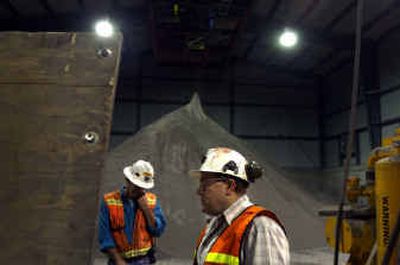Road to smelter paved with irony

While American regulators spar with Canadian mining company Teck Cominco Ltd. over a cleanup plan for its Columbia River pollution, U.S. taxpayers are paying to improve a remote road in northeastern Washington that will help the company’s bottom line.
A 12.5-mile stretch of State Route 31 from Metaline Falls to the Canadian border will get millions of dollars worth of improvements to enable trucks to carry zinc and lead concentrates from Teck Cominco’s new Pend Oreille Mine to its smelter in Trail, B.C., year-round.
The Washington state Department of Transportation describes the road improvement as an “economic development” project that supports 151 new jobs at the $74 million mine, a wholly owned Teck Cominco subsidiary that opened this year.
Critics argue it’s wrong for American taxpayers to assist Teck Cominco, a company fighting the U.S. Environmental Protection Agency over a cleanup plan for its slag and heavy metals pollution in the Columbia.
“It’s totally ironic,” said Dave Heflick of Kettle Falls, director of the forests and rivers program of the Northwest Ecosystem Alliance, a group that’s fighting for a thorough cleanup of Lake Roosevelt.
“While Teck Cominco claims our government has no authority to order it to clean up the Columbia, a river it’s used for a century to flush its wastes, the U.S. government is spending taxpayer dollars to repave a highway to help Teck Cominco,” Heflick said.
“The irony is pretty unmissable – we aren’t sending a consistent message across the border,” Heflick added.
Teck Cominco’s increased truck traffic along State Route 31, “and the jobs that depend on it, requires that the roadway be able to withstand legally loaded trucks 365 days a year,” according to a recent Department of Transportation press release.
The road project won’t just benefit Teck Cominco, said Pend Oreille Mine manager Mark Brown. Many other motorists, tourists and commercial trucks, including loaded logging trucks, use SR 31 between the two countries, he said.
But the SR 31 project will make Dave Kurulok’s job a lot easier – speeding up his trip to the Canadian smelter.
Kurulok, of Montrose, B.C., is a driver for Trimac Transportation, the Canadian hauling company with the Teck Cominco contract to transport concentrated ores from the Pend Oreille Mine.
Kurulok, who stopped to talk last Wednesday at the border as he cleared Canadian customs, says he makes the trip to the mine four times a day. That’s because the 105,000-pound load restriction on the American road he travels allows him to transport only one ore trailer, called a “pup.” He drives it north to the border, unhooks the load, turns around and retrieves a second load at the Pend Oreille Mine.
Back at the Canadian border, he hooks the two loads together and proceeds to Trail along Canadian highways, which allow heavier loads of 184,000 pounds.
SR 31’s improved design will allow moisture that gathers under the road surface to dissipate through new layers of gravel, keeping the highway intact and making it less dangerous, according to the state Department of Transportation. Currently, heavy truck traffic damages the road during spring thaws, forcing seasonal weight restrictions and limiting freight movements.
The precise cost of the multimillion-dollar project won’t be known until next month after bids are opened, said Al Gilson, Department of Transportation spokesman.
Two rival Washington state politicians went to bat for the SR 31 project.
Republican Rep. George Nethercutt, and Democratic Sen. Patty Murray obtained a $1.6 million earmark in the recently passed federal transportation budget for part of the project.
That money will replace a narrow, 22-foot wide bridge over Sullivan Creek along SR 31, south of the mine’s entrance.
It’s not fair to say the project only benefits Teck Cominco, said Nethercutt spokeswoman April Isenhower. “I don’t think the will to secure this money would have been there solely to help a Canadian company. It was to improve the road for everyone. The congressman has heard complaints for years that the road isn’t safe in winter,” Isenhower said.
Murray’s office didn’t return a call seeking comment.
Teck Cominco’s U.S. political action committee is supporting Nethercutt in his effort to unseat Murray, federal election records show. Cominco PAC has donated $2,000 to Nethercutt’s campaign since last June, and also gave $2,000 to a 5th District congressional contender, Republican State Rep. Cathy McMorris, last November.
In a January letter to the EPA, Murray said she supports the agency’s Superfund cleanup order to Teck Cominco for its Lake Roosevelt pollution. Nethercutt has supported a diplomatic solution to the standoff that’s also favored by the company.
The bridge project will start in 2006. The rest of the SR 31 improvements involve placing a rock cap on top of the existing asphalt and gradually building up additional asphalt and gravel layers.
Meanwhile, the Pend Oreille Mine is on its way to full production.
The mine’s payroll is now between $9 million and $11 million, Brown, the manager, said. It employs 151 people earning between $11.50 and $21.25 an hour, with full benefits. As many as nine trucks a day have been hauling the mine’s high-grade zinc and lead concentrates to the Trail smelter seven days a week since January.
Thirteen trucks will be required daily at full production, Brown said, when the mine will produce 50,000 tons of zinc a year. The big Trail smelter uses about 290,000 tons of zinc ore concentrates each year. Another major ore source for the smelter is the Red Dog Mine.
Teck Cominco put $74 million into the Pend Oreille Mine, which had been closed since 1977, in order to compensate for the closure of its Sullivan Mine in British Columbia. The renovated mine is projected to operate for 10 years, but there’s also a potential for more ore reserves in the area that could extend its life, said Brown, who formerly managed the Sullivan Mine.
“This mine made economic sense to us because it’s close to the smelter. It’s 51.8 miles gate to gate,” Brown said.